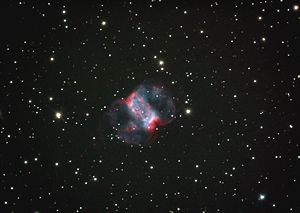astro.wikisort.org - Nebulosa
La nebulosa Dumbbell Pequeña (también conocida como nebulosa Planetaria M76, Messier 76, M76 o NGC 650/NGC 651), es una nebulosa planetaria situada en la constelación de Perseo.
| Nebulosa Dumbbell Pequeña | ||
|---|---|---|
 | ||
| Datos de observación: Época J2000.0 | ||
| Ascensión recta | 1h 42,4m | |
| Declinación | +51° 34′ | |
| Distancia | 3.400 al | |
| Magnitud aparente (V) | +10,1 | |
| Tamaño aparente (V) | 2,7 × 1,8 minutos de arco | |
| Constelación | Perseo | |
| Características físicas | ||
| Radio | - al | |
| Magnitud absoluta (V) | - | |
| Otras características | - | |
| Otras designaciones | M76, NGC 650 | |
El 5 de septiembre de 1780 fue descubierta por Pierre Méchain, informó a Charles Messier quien determinó su posición y la añadió a su catálogo. Pierre Méchain creía que era una nebulosa sin estrellas, Charles Messier que estaba compuesta por pequeñas estrellas con algo de nebulosidad, probablemente distorsionadas por estrellas anteriores y posteriores. En 1866 William Huggins dijo que su espectro era gaseoso. Pero no fue hasta 1918 cuando Heber Curtis lo clasificó correctamente como una nebulosa planetaria.
Messier 76 está entre los objetos más débiles del Catálogo Messier y se le han dado dos números NGC ya que se pensaba que era una nebulosa doble, William Herschel fue quien la enumeró como HI 193. Y la parte noroeste como NGC 650.
Enlaces externos
- Messier 76 - SEDS Messier (en inglés)
- Datos básicos de M76, bibliografía y otros en la base de datos SIMBAD (en inglés)
На других языках
[de] Kleiner Hantelnebel
Der kleine Hantelnebel (auch als Messier 76 oder NGC 650 bezeichnet) ist ein planetarischer Nebel im Sternbild Perseus am Nordsternhimmel mit einer scheinbaren Helligkeit von 10,1 mag. Der hellere Kernbereich der auch als „Korken“ bezeichnet wird misst 1,45' × 0,7' Bogenminuten. Der etwas schwächere äußere Teil hat knapp die doppelte Ausdehnung. Wegen dessen Form wird das Objekt Schmetterlingsnebel oder kleiner Hantelnebel genannt. Ganz außen herum befindet sich ein Halo, der aus jenem Gasmaterial besteht, welches der Stern bereits lange vor der Explosion in seiner Phase als Roter Riese abgegeben hatte. Dieser ist knapp 4,8 Bogenminuten groß. Diesem Wert entspricht in der Entfernung des Nebels eine absolute Ausdehnung von etwa 21 Lichtjahren.[en] Little Dumbbell Nebula
The Little Dumbbell Nebula, also known as Messier 76, NGC 650/651, the Barbell Nebula, or the Cork Nebula,[1] is a planetary nebula in northern constellation Perseus. It was discovered by Pierre Méchain in 1780 and included in Charles Messier's catalog of comet-like objects as number 76. It was first recognised as a planetary nebula in 1918 by the astronomer Heber Doust Curtis. However, there is some contention to this claim, as Isaac Roberts in 1891 did suggest that M76 might be similar to the Ring Nebula (M57), being instead as seen from the side view.[2] The structure is now classed as a bipolar planetary nebula (BPNe), denoting two stars which have burst, leaving neutron star or white dwarf remnants and luminous envelopes.[3] Distance to M76 is currently estimated as 780 parsecs or 2,500 light years,[4] making the average dimensions about 0.378 pc. (1.23 ly.) across.[5]- [es] Nebulosa Dumbbell Pequeña
[ru] Туманность Маленькая Гантель
Туманность Маленькая Гантель (также M 76, PK 130-10.1, NGC 650/651) — планетарная туманность в созвездии Персей. Открыта в 1780 году. Первоначально считалось, что она состоит из двух отдельных туманностей и поэтому ей дали два номера в каталоге NGC, 650 и 651. Это один из наиболее тусклых объектов в списке Мессье.Другой контент может иметь иную лицензию. Перед использованием материалов сайта WikiSort.org внимательно изучите правила лицензирования конкретных элементов наполнения сайта.
WikiSort.org - проект по пересортировке и дополнению контента Википедии